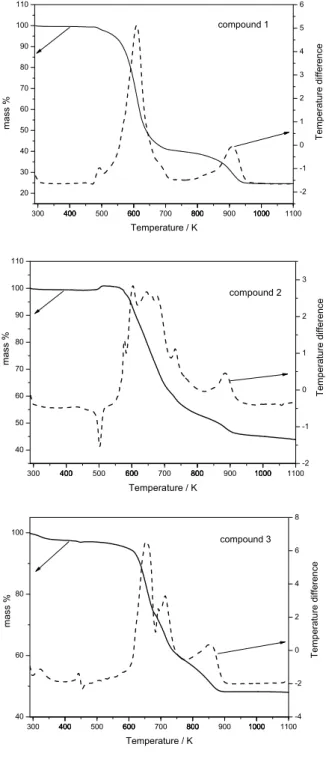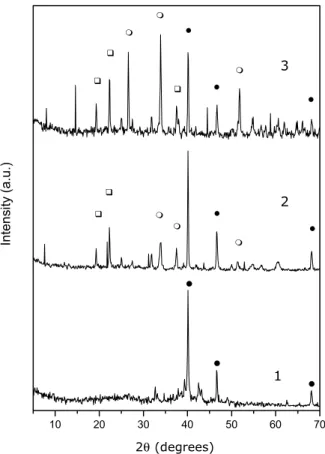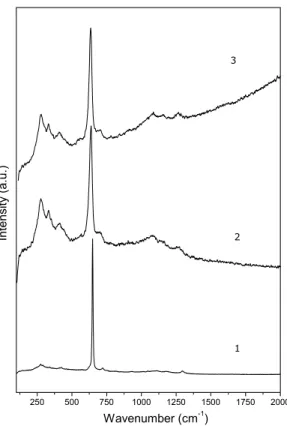(Annals of the Brazilian Academy of Sciences) ISSN 0001-3765
www.scielo.br/aabc
Thermal properties of metal-metal bonded Pd(I)
complexes supported onto porous Vycor glass
IARA F. GIMENEZ1,2 and OSWALDO L. ALVES1
1LQES – Laboratório de Química do Estado Sólido, Instituto de Química – UNICAMP,
Caixa Postal 6154, 13084-971 Campinas, SP, Brasil
2Departamento de Química, CCET/UFS, Campus Universitário Prof. José Aloísio de Campos,
Av. Marechal Rondon s/n, 49100-000, São Cristovão, SE, Brasil
Manuscript received on October 6, 2006; accepted for publication on October 23, 2007;
contributed byOSWALDOL. ALVES*
ABSTRACT
Thermal behavior of the complexes Pd2(dppm)2Cl2, Pd2(dppm)2(SnCl3)Cl and Pd2(dppm)2(SnCl3)2 (dppm = bis[diphenylphosphino(methane)], ((C6H5)2PCH2P(C6H5)2) in the solid state and immobilized onto porous Vycor glass was studied. Similar decomposition mechanisms were observed for the solid and immobilized complexes, with a small thermal stabilization upon immobilization. The decomposition products were characterized by X-ray diffrac-tometry, Raman and diffuse reflectance infrared spectroscopy, which indicated the presence of a mixture of metallic palladium and oxidized species such as PdO, condensed phosphates, SnO2and SnP2O7. According to X-ray diffractom-etry, the decomposition products of the immobilized complexes presented higher amounts of PdO than the solid-state residues, probably as an effect of interactions with silanol groups present in the glass surface.
Key words:palladium(I) complex, porous Vycor glass, bis[diphenylphosphino(methane)], thermogravimetric analysis.
INTRODUCTION
The study of supported organometallics and transition metal complexes is motivated mainly by applications as catalysts (Ando et al. 2004, Kureshi et al. 2004) and molecular precursors to advanced materials such as gas sensors (Alves et al. 2005, Silva et al. 2006), semicon-ductors, and metallic particles (Sunil et al. 1993). In par-ticular, heterogeneous catalysts containing Pd or Pt have been studied owing to their activity in oxidation of CO, hydrogenation, (Evrard et al. 2004) and electrochemical oxidations (Yang and McElwee-White 2004). A pre-vious paper by Richmond and co-workers reported the preparation of dinuclear phosphine-bridged palladium(I) species and their silica-bound analogues as catalysts for the cyclization of aminoalkynes, showing that in some
*Member Academia Brasileira de Ciências Correspondence to: Oswaldo L. Alves E-mail: oalves@iqm.unicamp.br
cases the catalytic activity is improved by the higher thermal stability of the supported catalyst (Richmond et al. 2002).
The family of complexes of interest here includes the complex containing metal-metal bonded Pt(I) atoms Pt2(dppm)2Cl2(Glocking and Pollock 1972) and its pal-ladium analogue, which can be used as homogeneous catalysts in several reactions (Kirss and Eisenberg 1989). The derivatives of SnCl2 insertion into Pd-Cl bonds of Pd2(dppm)2Cl2also catalyze the alkoxycarbonylation of terminal alkenes (Nguyen et al. 2005). In this context, the thermal behavior of free and supported complexes is important both to evaluate the thermal stability and to identify decomposition products. However, for the com-plexes of interest here this aspect was still unexplored.
com-pounds onto polystyrene for application in separation of gases were unsuccessful due to steric demands (Lee et al. 1986). Recently we described the immobi-lization of Pd2(dppm)2Cl2, Pd2(dppm)2(SnCl3)Cl, and Pd2(dppm)2(SnCl3)2onto porous Vycor glass (Gimenez and Alves 2002, 2004), which proved to be suitable precursors for gas sensing systems (Alves et al. 2005, Silva et al. 2006). We were further interested in study-ing the thermal stability of these immobilized species, since the gas insertions into the metal-metal bond can be reverted both by heating and inert-gas flow. In this paper we report the thermogravimetric study of the complexes Pd2(dppm)2Cl2, Pd2(dppm)2(SnCl3)Cl, and Pd2(dppm)2(SnCl3)2, both in the solid state and immo-bilized onto porous Vycor glass, as well as the character-ization of the decomposition products by XRD, DRIFT, and Raman spectroscopy.
MATERIALS AND METHODS
PREPARATION OFSOLID ANDSUPPORTEDCOMPLEXES
All the syntheses were carried out using solvents purified and dried by standard methods. PdCl2, dppm and anhy-drous SnCl2were purchased from Aldrich and used with-out further purification. The complexes Pd2(dppm)2Cl2 (1), Pd2(dppm)2(SnCl3)Cl (2) and Pd2(dppm)2(SnCl3)2 (3) were prepared by methods described in the literature (Balch and Benner 1982, Olmstead et al. 1979).
IMMOBILIZATIONEXPERIMENTS
The complexes were immobilized onto 1-mm thick pol-ished Vycor 7930 glass plates. Immobilization exper-iments were carried out by immersion of 10×10× 1 mm glass plates into 1 10–3mol L–1 methylene chlo-ride solutions of the complex at room temperature for 24 hours. The solvent was removed under vacuum. The PVG-supported complexes will be referred in the text as
PVG/1(PVG/Pd2(dppm)2Cl2),
PVG/2(PVG/Pd2(dppm)2(SnCl3)Cl) and
PVG/3(PVG/Pd2(dppm)2(SnCl3)2.
THERMOGRAVIMETRICANALYSIS
Thermogravimetric analyses were carried out in a TA Instruments 2960, using platinum sample holders, under
the dynamic flow of dry synthetic air (20 mL min–1), at a heating rate of 10 K min–1.
PYROLYSISEXPERIMENTS
All pyrolysis experiments of solid and immobilized com-plexes were carried out in platinum crucibles under air for 24 h at specified temperatures.
X-RAY DIFFRACTOMETY(XRD)
X-ray diffractograms were obtained with a Karl Zeiss URD-6, using Cu-καradiation (λ=1.54060Å), with a step 2θ0.02/0.4 s.
RAMANSPECTROSCOPY
Raman spectra were recorded on a Renishaw Raman Imaging Microscope System 3000, coupled to an op-tical microscope with resolution 1.5µm and a He-Ne
(λ = 632.8 nm) laser source. Sampling was
accom-plished by scanning different surface regions of the sam-ple placed onto glass sheets.
FOURIERTRANSFORMEDDIFFUSEREFLECTANCE INFRAREDANALYSIS(DRIFT)
Diffuse reflectance infrared spectra were obtained with a Nicolet 520 spectrophotometer in the spectral range 4000-400 cm–1using KBr as reference.
RESULTS AND DISCUSION
In the TG curve of compound2, the mass gain start-ing from 474 K may be attributed to oxygen uptake. The mass increase at relatively low temperatures by oxygen absorption is commonly observed for Pd and Pt com-plexes such as [Pd(PPh3)4] and [Pt(PPh3)4], rendering species such as CO2−
3 and Ph3PO (phosphinoxide) (Bar-bieri et al. 1995). As verified in Figure 1, the mass gain is followed by a gradual mass loss from 546 K to 968 K. No clear plateau can be defined but the curve derivative shows a broad feature from 546 to 822 K correspond-ing to a 49% loss. Probably the decomposition involves elimination of P(Ph)2CH2Cl2plus one entire dppm (ex-pected loss: 52%).
For compound 3 the initial 2% loss due to elim-ination of water suggests the presence of SnCl2 (hy-groscopic) as an impurity. When this compound is put into CH2Cl2solution the following chemical equilibrium takes place (Olmstead et al. 1979):
Pd2(dppm)2(SnCl3)2 ⇋ Pd2(dppm)2(SnCl3)Cl+SnCl2
3 2
A large SnCl2excess is necessary in the synthesis lead-ing to the presence of SnCl2as a product impurity. Ex-haustive purification attempts by recrystallization will form compound2and, in fact these limitations precluded the crystal structure determination for this compound, since its earliest report (Olmstead et al. 1979). Accord-ing to TG curve, compound3degrades with continuous
mass loss from 413 K up to 916 K. In the range 586-683K the mass loss observed (24%) is coherent with loss of a P(Ph)2CH2Cl2 radical plus a Cl2 molecule (calculated 24%). The decomposition of the residue is gradative and incomplete with a final mass percent of 48%.
The decomposition products were characterized by XRD, DRIFT and Raman. According to X-ray diffrac-tion, Figure 2, the main decomposition product of solid complex1is metallic palladium (2θ=40.1◦, 46.6◦and 68.1◦ (JCPDS)). For the complexes 2 and 3, residues contain SnO2(2θ =26.5◦, 34◦, 38◦, 51.8◦) and SnP
2O7 (2θ = 19.2◦, 22.3◦, 37.6◦) in addition to metallic palladium.
DRIFT and micro-Raman spectroscopies suggested the presence of additional phases, mostly in the case of
1. For1, the Raman spectrum (Fig. 3) shows the
typi-cal features of PdO (Chan and Bell 1984), probably not detected by X-ray diffraction due to its concentration
400 600 800 1000
20 30 40 50 60 70 80 90 100 110
400 600 800 1000
-2 -1 0 1 2 3 4 5 6
300 400 500 600 700 800 900 1000 1100
compound 1 T e mp e ra tu re d if fe re n ce ma ss %
Temperature / K
300 400 500 600 700 800 900 1000 1100
40 50 60 70 80 90 100 110
400 600 800 1000
-2 -1 0 1 2 3
400 600 800 1000
compound 2 T e mp e ra tu re d if fe re n ce ma ss %
Temperature / K
300 400 500 600 700 800 900 1000 1100
40 60 80 100
400 600 800 1000
-4 -2 0 2 4 6 8
400 600 800 1000
ma
ss
%
Temperature / K
compound 3 T e mp e ra tu re d if fe re n ce
Fig. 1 – TG curves of compounds: Pd2(dppm)2Cl2 (1), Pd2(dppm)2(SnCl3)Cl (2) Pd2(dppm)2(SnCl3)2(3).
TABLE I
Thermogravimetric data for compounds1-3.
Compound T range (K) mass % mass (amu)
471-837 62 654
1 P(Ph)2CH2Cl2radical +dppm
837-970 13 133
474-519 2 (gain) 19
2 546-822 49 654
P(Ph)2CH2Cl2radical +dppm
822-968 7 85
298-379 2 29
H2O
413-454 1 9
3
586-683 24 341
P(Ph)2CH2Cl2radical + Cl2
683-769 14 206
769-916 11 152
10 20 30 40 50 60 70
1
In
te
n
s
it
y
(a
.u
.)
2
2θ (degrees)
3
Fig. 2 – X-ray diffractograms of the decomposition products after heating compounds1-3at 1000◦C. Assignments over the peaks refer
to the phases:• =Pd,O=SnO2,=SnP2O7.
DRIFT spectrum of1(not shown) showed a broad band around 1000 cm–1suggesting the presence of condensed phosphates. For2 and3, SnP2O7 already detected by XRD was confirmed due to the bands at 1160 cm–1and 1026 cm–1, assigned toν
sym(P-O) andνasym(P-O) from
terminal PO2−
3 groups, respectively, and at 748 cm–1
assigned toνsym(P-O) from P-O-P bridges (Hubin and
Tarte 1967, Guan et al. 2005). Also a strong band at 1280 cm–1 can be assigned to intra-chain PO
2moieties from condensed phosphates.
stabi-250 500 750 1000 1250 1500 1750 2000 2
1
In
te
n
s
it
y
(
a
.u
.)
Wavenumber (cm-1) 3
Fig. 3 – Micro-Raman spectra of the decomposition products after heating compounds1-3at 1000◦C.
lization of the supported complex. The thermal decom-position of PVG/2starts at 510 K, with a deflection at
563 K and a gradual mass loss up to 919 K. Finally, for PVG/3mass losses at 488 K, 573 K and 740 K can be observed, slightly higher than in the solid state.
400 600 800 1000
93 94 95 96 97 98 99 100
400 600 800 1000
94 96 98 100
300 400 500 600 700 800 900 1000 94
96 98 100
PVG/1 PVG/2
M
a
ss
(%
)
Temperature (K)
PVG/3
Fig. 4 – TG curves of samples: PVG/1, PVG/2and PVG/3.
TABLE II
Thermogravimetric data for samples PVG/1-3.
Sample T range % %(mass)
of events (K) immobilized*
295–403 -3
PVG/1 449–514 -1 3
533–603 -1
295–395 -3
PVG/2 510–562 -1 5
563–816 -2
295–403 -2
PVG/3 488–573 -1 5
573–740 -1
*estimate.
As glass signals dominated the DRIFT and Raman spectra of PVG samples, only XRD was able to detect residues of the complexes. Interestingly in this case PdO peaks are observed in addition to metallic Pd for all sam-ples, suggesting that the close contact of the complexes with silanol groups facilitates the formation of PdO, in contrast to the behavior of the solid complexes. For PVG/2and PVG/3the peaks of metallic palladium are weak in comparison to SnO2and SnP2O7peaks.
From the results of thermal analysis and character-ization of the decomposition products, we conclude that the thermal stability of the complexes is improved by immobilization onto porous Vycor glass and the com-position of the residues presents some differences. The decomposition mechanism is complex and involves con-comitant processes such as elimination of P(Ph)2CH2Cl2 radicals and Cl2 molecules. The residues, both in the solid state and embedded in the glass, consist of a mixture of compounds such as oxides, phosphates and metallic palladium.
ACKNOWLEDGMENTS
The authors are grateful to Fundação de Amparo à Pes-quisa do Estado de São Paulo (FAPESP, Brazil) for the financial support.
RESUMO
(TG), no estado sólido e imobilizados no vidro poroso Vycor, são descritos. Os mecanismos de decomposição dos complexos no estado sólido e imobilizados no vidro poroso Vycor são similares e apenas uma ligeira estabilização é observada me-diante a imobilização. Os produtos de decomposição foram caracterizados por difração de raios-X, espectroscopias Raman e de Refletância difusa no infravermelho, indicando a presença de uma mistura de paládio metálico e espécies oxidadas tais como PdO, fosfatos condensados, SnO2 e SnP2O7. Os pro-dutos de decomposição dos complexos imobilizados no PVG apresentaram quantidades mais elevadas de PdO do que os resíduos no estado sólido, segundo a difração de raios-X, em virtude provavelmente da ocorrência de reações com grupa-mentos da superfície do vidro, bem como pelo fato de que as moléculas adsorvidas se encontram isoladas umas em relação às outras.
Palavras-chave:complexos de paládio(I), vidro poroso Vycor, bis[difenilfosfino)metano, análise termogravimétrica.
REFERENCES
ALVESFL, RAIMUNDOJR IM, GIMENEZIFANDALVES OL. 2005. An organopalladium-PVC membrane for sul-phur dioxide optical sensing. Sensors Actuators B 107: 47–52.
ANDO R, YAGYUT AND MAEDA M. 2004. Characteri-zation of oxovanadium (IV)-Schiff-base complexes and those bound on resin, and their use in sulfide oxidation. Inorg Chim Acta 357: 2237–2244.
BALCHALANDBENNER LS. 1982. Binuclear transition-metal complexes bridged by methylenebis(diphenylphos-phine). Inorg Synth 21: 47–50.
BARBIERI RS, BELLATOCRAND MASSABNI AC. 1995. Thermal-analysis of coordination-compounds .3. thermal-decomposition of platinum complexes containing tri-phenylphosphine, triphenylarsine and triphenylstibine. Thermochim Acta 259: 277–286.
CHAN SS AND BELL AT. 1984. Characterization of the preparation of Pd/SiO2 and Pd/La2O3 by laser Raman-spectroscopy. J Catal 89: 433–441.
EVRARDD, GROISONK, MUGNIERYANDHARVEYPD. 2004. The Pd4(dppm)4(H)22+cluster: a precatalyst for the homogeneous hydrogenation of alkynes. Inorg Chem 43: 790–796.
GIMENEZIFANDALVESOL. 2002. Immobilisation of com-plexes containing metal-metal bonds in porous Vycor glass and subsequent insertion of gas molecules into the Pd-Pd bonds. Glass Technol 43C: 166–169.
GIMENEZ IF AND ALVES OL. 2004. Properties of [Pd2X2(dppm)2] (X = Cl, SnCl3, dppm = bis(diphenyl-phosphino)methane) complexes on porous vycor glass. J Braz Chem Soc 15: 640–645.
GLOCKINGFANDPOLLOCKRJI. 1972. Novel dimeric pla-tinum(I) complex. J Chem Soc Chem Commun 88: 467– 467.
GUANX-H, LIUQ, CHENGHANDSHANGC. 2005. Sur-face complexation of condensed phosphate to aluminum hydroxide: An ATR-FTIR spectroscopic investigation. J Colloid Interface Sci 289: 319–327.
HOODHANDNORDBERGME. 1938. Treated borosilicate glass. US Patent 2,106,744.
HOODHPANDNORDBERGME. 1942. Method of treating borosilicate glasses. US Patent 2,286,275.
HUBINRANDTARTEP. 1967. Spectre d’absorption infra-rouge des pyrophosphates et pyroarseniates cubiques d’éléments tetravalents X6P2O7 et X6As2O7. Spectro-chim Acta 23A: 1815–1815.
JCPDS – JOINTCOMMITTEE ONPOWDERDIFFRACTION STANDARDSFILES– International Centre for Diffraction Data.
KIRSSRUANDEISENBERGR. 1989. Di(phosphine)-bridged complexes of palladium – parahydrogen-induced polar-ization in hydrogenation reactions and structure determi-nation of tris(µ -bis(diphenylphosphino)methane)dipalla-dium, Pd2(dppm)3. Inorg Chem 28: 3372–3378. KURESHYRI, KHANNUHANDABDISHR. 2004.
Dica-tionic chiral Mn(III) salen complex exchanged in the in-terlayers of montmorillonite clay: a heterogeneous enan-tioselective catalyst for epoxidation of nonfunctionalized alkenes. J Catal 221: 234–240.
LEEC-L, YANGY-P, RETTIGSJ, JAMESBR, NELSONDA ANDLILGAMA. 1986. Synthesis and characterization of dinuclear palladium(I) and mononuclear palladium(II) complexes containing 1,1-bis(diphenylphosphino)ethane (dpmMe) and related mixed-ligand complexes contain-ing dpmMe with either bis(diphenylphosphino)methane (dpm) or 2-(diphenylphosphino)pyridine (Ph2Ppy) – X-ray crystal-structures of PdCl2(dpmMe) and Pd2Cl2(µ -dpmMe)2. Organomet 5: 2220–2228.
MACEDO JS, OTUBO L, FERREIRA OP, GIMENEZ IF, MAZALIIOANDBARRETOLS. 2008. Biomorphic acti-vated porous carbons with complex microstructures from lignocellulosic residues, Microporous Mesoporous Mater 107: 276–285.
the catalyzed alkoxycarbonylation reaction of terminal alkenes. J Organomet Chem 690: 2947–2951.
OLMSTEADMM, BENNERLS, HOPEHANDBALCHAL. 1979. Addition of tin(II) chloride to
Pd2(Ph2PCH2PPh2)2Cl2 – Crystal and molecular-struc-ture of Pd2(Ph2PCH2PPh2)2(SnCl3)Cl. Inorg Chim Acta 32: 193–198.
RICHMOND MK, SCOTT SL, YAP GPA AND ALPER H. 2002. Preparation of dinuclear phosphine-bridged palla-dium(II) species and their silica-bound analogues as cata-lysts for the cyclization of aminoalkynes. Organomet 21: 3395–3400.
SILVAKRB, RAIMUNDOJRIM, GIMENEZIFANDALVES OL. 2006. Optical sensor for sulphur dioxide determina-tion in wines. J Agric Food Chem 54: 8697–8701.
SUNILD, SOKOLOVJ, RAFAILOVICHMH, DUANXAND GAFNEY HD. 1993. Evidence for the photodeposition of elemental iron in porous vycor glass. Inorg Chem 32: 4489–4490.
YANGYANDMCELWEE-WHITEL. 2004. Electrochemical oxidation of methanol using dppm-bridged Ru/Pd, Ru/Pt and Ru/Au catalyst. Dalton Trans 15: 2352–2356. ZAYED MA, ARIFIEN AESA AND HASSAN FSM. 1999.


